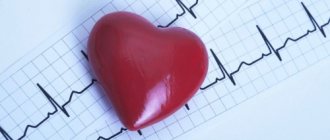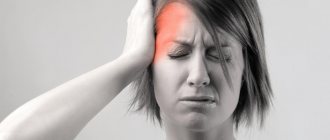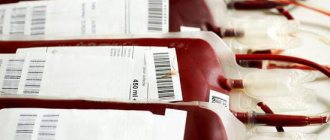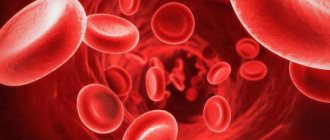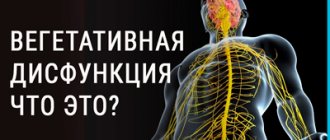Causes of hot flashes to the head
Physiological factors
A feeling of heat and a rush of blood to the head occurs during intense physical activity, especially in untrained people with excess body weight.
There is a feeling that your face is on fire. The skin becomes noticeably red and very warm to the touch. Hot flashes are accompanied by a feeling of fullness and heaviness in the head, and sometimes there is tinnitus. Unpleasant sensations disappear 10-20 minutes after rest. Hot flashes to the head are observed with psycho-emotional stress, severe anxiety, and shame. A person feels his face flush and his skin becomes hot. Sometimes an unpleasant pulsation in the head and discomfort in the stomach develop. This condition occurs periodically in any person, but frequent repetition of attacks, combined with the fear of blushing, may indicate erythrophobia.
Menopausal syndrome in women
Hormonal changes during menopause are the main etiological factor for hot flashes to the face and head in women. Attacks begin suddenly and are provoked by staying in a stuffy room, anxiety, or eating spicy or hot food. The woman feels an unpleasant heat and burning sensation in the head and neck. The skin very quickly turns pink or becomes covered with red spots. There is severe sweating of the face and neck, when sweat literally runs down the skin.
The feeling of heat is accompanied by headache, dizziness, a feeling of lack of air, and increased anxiety. After 5-15 minutes, the feeling that blood has rushed to the head disappears, but the redness may persist for a long time. Such paroxysms are observed from 5 to 20 or more times per day. The most intense and painful flushes of heat to the head occur at night, as a result of which patients suffer from insomnia.
Vegetative-vascular dystonia
Dysfunction of nervous regulation is characterized by a polymorphism of symptoms. VSD is often manifested by a rush of blood and heat to the head, and increased sweating in this area. In addition to these signs, patients experience dull pain in the temples and the back of the head, a feeling of a “pressing hoop” around the head, and dizziness. Hot flashes in the form of vegetative paroxysms occur with varying frequency, are provoked by emotional overstrain, but more often develop without visible factors.
Hot flashes to the head
Cardiovascular diseases
Sudden flashes of heat, accompanied by a severe headache and flashing spots before the eyes, are characteristic of a hypertensive crisis. Due to the expansion of superficial vessels, the skin of the face and upper half of the body turns red and becomes noticeably hot. Increased sweating is observed. Similar signs are typical for the neurovegetative form of hypertensive crisis.
Periodic redness, a feeling of vascular congestion and a rush to the head occur in hypertensive patients even with normal working pressure. Occasionally, attacks of facial redness with fever without fever occur with atherosclerosis. Such disorders are combined with headaches, dizziness, and tinnitus. Hot flashes are possible at any time of the day and are not associated with external provoking factors.
Complications of pharmacotherapy
Hot flashes in the head and neck are a side effect of taking nitrates to lower blood pressure. The symptom appears within a few minutes after rapid intravenous administration of drugs. The consequence of vasodilation is intense redness of the facial skin, patients feel fever and a throbbing headache. When trying to take a vertical position, dizziness and darkening of the eyes occur, caused by a sharp drop in blood pressure.
Rare causes
- Sleep pathologies
: sleep apnea syndrome, nightmares. - Withdrawal syndrome
: with alcoholic delirium, drug addiction. - Allergic reactions
: urticaria, Quincke's edema. - Damage to the central nervous system
: traumatic brain injury, neoplasms of the hypothalamic-pituitary system, post-concussion syndrome. - Endocrine disorders
: male menopause, diabetes mellitus, adrenal hyperfunction and pheochromocytoma.
Feeling hot
Menopause
Diabetes
21220 August 24
IMPORTANT!
The information in this section cannot be used for self-diagnosis and self-treatment.
In case of pain or other exacerbation of the disease, diagnostic tests should be prescribed only by the attending physician. To make a diagnosis and properly prescribe treatment, you should contact your doctor. The feeling of heat that a person experiences occurs due to a sharp expansion and blood filling of small subcutaneous vessels. This condition is called arterial hyperemia. At the same time, the skin turns red and becomes hot.
The lumen of blood vessels is regulated by the sympathetic and parasympathetic nervous system. Its changes depend on signals from the vasomotor (vasomotor) center of the central nervous system, hormones, pyrogenic (heat-causing) substances entering the blood, and a number of other factors.
Types of sensations of heat
The vessels are constantly influenced by factors that have a vasoconstrictor or vasodilator effect. For example, under stress, blood vessels narrow under the influence of the hormone adrenaline, and the skin turns pale. At the end of the stressful situation, the vessels relax and fill with blood.
Pathological arterial hyperemia, which is accompanied by a feeling of heat, develops either under the influence of irritants (infections, toxins, tissue breakdown products from burns, pyrogenic substances), or due to a violation of nervous regulation.
There are
neurogenic
arterial hyperemia (occurring in response to irritation of nerve endings) and
metabolic
(caused by the action of local chemical factors). An example of neurogenic arterial hyperemia is redness of the face and neck during hypertension, menopausal syndrome, and also during strong emotions.
Blood electrolytes have a metabolic effect on vascular tension: calcium and sodium constrict blood vessels and increase blood pressure, while potassium and magnesium, on the contrary, dilate them. Metabolic regulators include carbon dioxide, organic acids, and hormones.
Possible causes of feeling hot
Hot, hot and spicy foods can cause a rush of blood to the skin and a feeling of heat.
Alcohol has the same effect on the body.
, which promotes the dilation of blood vessels.
Taking certain medications
can also cause a feeling of heat spreading throughout the body. These include vasodilators, hormonal agents, antidepressants, etc.
The causes of arterial hyperemia and, as a result, feelings of heat can be different. If the regulation of vascular tone is disturbed, arterial hypertension may develop, accompanied by a sudden increase in blood pressure - a hypertensive crisis. The most common cause of this condition is hypertension. However, in a third of cases, arterial hypertension is caused by diseases of the internal organs: acute glomerulonephritis and other kidney damage, adrenal tumors and other diseases of the endocrine system. The magnitude of the rise in blood pressure during a hypertensive crisis depends on the age and individual characteristics of the person. At a young age, symptoms of a crisis may occur at a lower level of blood pressure, and at an older age – at a higher level.
A sharp increase in blood pressure is accompanied by headache, dizziness, nausea, vomiting, visual disturbances (“floaters”, double vision). Possible numbness of the limbs, a feeling of pins and needles, rapid heartbeat, shortness of breath.
Due to a violation of nervous regulation, chills occur, followed by fever, and increased sweating. The end of the crisis is accompanied by frequent urination.
Increased blood pressure and the symptoms accompanying this condition also occur with an adrenal tumor - pheochromocytoma
and other hormone-producing tumors. The tumor secretes large amounts of catecholamines (adrenaline and norepinephrine).
Clinical signs of pheochromocytoma may include headache, sweating, increased heart rate, irritability, weight loss, chest pain, nausea, vomiting, weakness, and fatigue. In some cases, patients may experience fever, shortness of breath, hot flashes, increased thirst, increased urination, dizziness, and tinnitus.
Many women complain of hot flashes during menopause
. Changes in hormonal levels occur even before the cessation of menstruation, during premenopause (menopausal transition). At first, its manifestations are insignificant, and most often they are not given importance or are attributed to the consequences of fatigue and mental stress. Hormonal and metabolic changes, in particular, a decrease in the level of estrogen, progesterone and an increase in the production of GnRH, are accompanied by hot flashes, which can be repeated several times a day.
Women describe them as a periodic short-term feeling of heat followed by chills, increased sweating, and rapid heartbeat.
In most cases, hot flashes only slightly affect your well-being.
Arterial hyperemia and a feeling of heat can be a sign of dysfunction of the thyroid gland, for example, with thyrotoxicosis
. Patients with thyrotoxicosis complain of general weakness, fatigue, irritability, sleep disturbance, sweating, trembling fingers, palpitations, and sometimes pain in the heart area.
Despite the increased appetite, patients with thyrotoxicosis lose weight.
Violation of thermoregulation, which occurs due to accelerated metabolism, leads to an increase in body temperature and causes a constant feeling of heat. The skin becomes warm and moist, the skin vessels dilate, which is accompanied by redness of the face. Sweating increases, nails become brittle, and hair falls out.
Sometimes hot flashes and a feeling of heat in combination with high blood pressure occur with diabetes mellitus
. These symptoms are accompanied by general malaise, sweating, thirst, and an increase in the volume of urine produced.
Which doctors should I contact?
If symptoms such as fever and hot flashes appear regularly, you need to contact, who, based on the complaints and tests, will refer you to or.
Diagnostics and examinations
The appearance of periodic hot flashes, accompanied by a feeling of heat, sweating, and redness of the facial skin, requires mandatory diagnosis.
The doctor evaluates the patient's complaints, taking into account age, gender and concomitant diseases. When blood pressure increases, turning into crises, it is necessary to determine the nature of the pathology - primary (associated with a violation of nervous regulation) or secondary (due to diseases of the internal organs). For this purpose, a clinical blood test and a general urine test, a urine test according to Nechiporenko, a blood test for glucose, cholesterol, and creatinine are prescribed.
Diagnostics
Depending on the symptoms that accompany hot flashes to the head, the patient is prescribed a consultation with an endocrinologist, neurologist, or cardiologist. During the initial examination, the doctor asks how long the attacks have been bothering you, how often they appear and what is triggered. The specialist conducts a physical examination, measures blood pressure and heart rate, and listens to heart sounds. The plan of laboratory and instrumental diagnostic studies includes:
- Neurological examination
. The specialist checks the basic deep and superficial reflexes and their symmetry. Using special tests and questionnaires, it establishes the correct functioning of the autonomic nervous system. If an organic lesion of the central nervous system is suspected, an EEG, CT or MRI of the brain is performed. - ECG.
A quick and non-invasive method is used to detect heart pathology. Based on the results of the cardiogram, the doctor diagnoses myocardial hypertrophy, arrhythmia, conduction disorders - the causes that cause hot flashes. To clarify the diagnosis, echocardiography is recommended; in rare cases, invasive coronary angiography is indicated. - Blood tests
. The level of cortisol, adrenaline, thyroxine and other hormones that contribute to a rush of blood and heat to the head are assessed. Women undergo an extended hormonal profile with the determination of estrogens, progesterone, FSH and LH. In men, the amount of testosterone is measured. Be sure to analyze the results of the lipid profile.
In case of possible endocrine disorders, the results of ultrasound of the adrenal glands and thyroid gland are taken into account. To assess the emotional state and exclude various phobias and neuroses that cause hot flashes, a consultation with a psychiatrist is required. Women of reproductive age who regularly experience paroxysms should visit a gynecologist - sometimes hot flashes develop due to dysfunction of the reproductive organs.
Dosed physical activity improves autonomic regulation
Rush of blood to the head (feeling of heat)
A rush of blood to the head is accompanied by a feeling of heat, which instantly spreads throughout the body. During this time, the following symptoms may be observed:
- slight increase in body temperature; - slight increase in heart rate; - redness of the facial skin, the appearance of red spots; - profuse sweating.
Sometimes these symptoms are supplemented by difficulty breathing, mental anxiety, flickering in the eyes and ringing in the ears. The duration of such states ranges from 30 seconds to several minutes.
A frequent feeling of heat in the head may be a consequence of dysfunction of the cardiovascular system, in particular, the result of high blood pressure. At such moments, to make sure the cause is correct, you should measure your blood pressure. Arterial hypertension requires timely treatment.
In addition, healthy people can also feel a rush of blood due to a sudden increase in blood pressure during stressful situations. Other risk factors include:
- alcohol consumption; - smoking; - excess body weight; - elderly age; - exhausting physical activity; - taking certain medications; - heredity.
Also, a rush of blood to the head in women can be a sign of approaching menopause (menopause). The causes of their occurrence are considered to be a decrease in estrogen levels and a combination of hormonal and biochemical fluctuations. Sometimes these are the first harbingers of menopause. This condition may be accompanied by increased sweating at night.
A third cause of flushing may be atherosclerosis. In this case, heaviness and noise in the head intensify, and pain appears in the temples. Taking a reclining position, taking a laxative, and applying a cold, damp cloth to the forehead can help get rid of the condition. In addition, you need to ensure the outflow of blood from the head: put mustard plasters on your calves, or put your feet in hot water.
You can alleviate the general condition of hot flashes in various ways, depending on the cause that caused them. If they arise as a result of excessive consumption of alcoholic beverages, severe physical or mental stress, nervous stress, prolonged exposure to stale air, frequent constipation, then you can resort to the following measures.
1. Organize your lifestyle. Try to avoid alcohol and energy drinks. 2. For constipation, give cleansing enemas and monitor your diet. 3. Take a cool shower in the morning. 4. Avoid clothes that restrict movement. 5. Monitor your psycho-emotional state.
Treatment
Help before diagnosis
A symptom caused by physiological reasons can be prevented: avoid excessive duration and intensity of physical activity, minimize stressful situations. Hot flashes to the head should not be ignored, as they may be the first symptom of serious cardiovascular or neurological disorders. If attacks occur frequently or are accompanied by deterioration in health, you should consult a doctor.
Conservative therapy
Most treatment for hot flashes occurs on an outpatient basis. Among the non-drug methods in the foreground are exercise therapy and dosed physical activity, which improve the state of autonomic regulation. In order not to provoke attacks, they select a diet with a limitation of pungent and extractive substances. Psychotherapy sessions are recommended to correct the emotional state.
The drug regimen is drawn up taking into account the cause of hot flashes. To normalize the functioning of the autonomic nervous system, sedatives, “daytime” tranquilizers, and antidepressants are used. Women experiencing menopausal syndrome undergo hormone replacement therapy, which quickly eliminates unpleasant symptoms. Men during menopause are also prescribed hormones - testosterone in tablet, injection or transdermal form.
In the treatment of hot flashes to the head, physiotherapeutic techniques play an important role. A good restorative and tonic effect is provided by balneotherapy (circular showers, carbon dioxide and radon baths), exposure to electric currents (interference therapy, electrical stimulation, diadynamic therapy). Methods of homeopathy and physiotherapy are shown as an addition to the main treatment regimen.
Patients who complain of redness and heat of the head due to the use of antihypertensive drugs (nitrates) should discuss therapy with their doctor and clinical pharmacologist. In some cases, it is necessary to adjust the dose and frequency of administration, and in case of severe iatrogenic hot flashes, drugs from other pharmacological groups are used.


